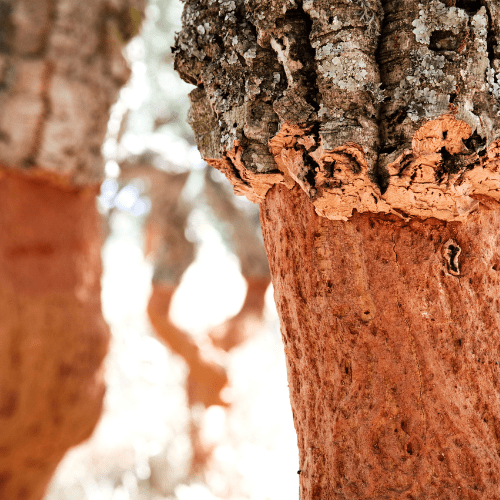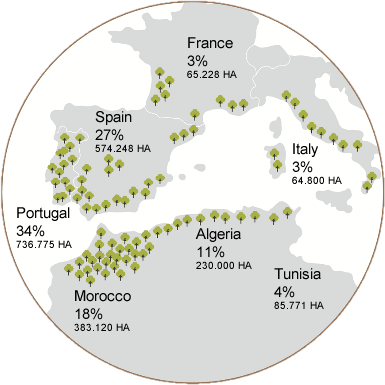
What is Cork?
Cork is the bark of the cork oak tree (botanically known as Quercus Suber L.). 100% natural, renewable, reusable and recyclable, cork is one of the most versatile materials in the world. The tree can live up to 200 years, during which time it may be harvested on average 17 times. No trees are cut or damaged during harvesting of the bark, on the contrary, regularly harvested trees will absorb and retain five times more CO2 than those that aren’t.
Cork is Sustainable & Rapidly-Renewable
In these times of increased concern for the environment, cork remains the ONLY tree that can regenerate itself after each harvest.
Cork tree bark consists of a honeycomb of microscopic cells filled with an air-like gas and coated mainly with suberin and lignin. A single cubic centimetre of cork contains almost 40 million cells – around 800 million in a single natural cork stopper.
Cork Life Cycle
-
![]()
The cork tree grows becoming part of the most important ecosystems in the world - on par with the Amazon, and the African Savanna.
-
![]()
After 25 years, the bark of the cork tree is harvested for the first time by skilled craftsmen who carefully strip the bark from the tree with hand axes. Thereafter, cork bark is harvested every 9 years for the next 200 years.
-
![]()
Bark is collected and transported to factories for further curing and processing.
-
![]()
100% of cork bark is used. And not just for cork-stoppers - from aerospace to designer shoes, cork wall coverings to cork furniture - Cork bark has multitude of applications.

Where Do Cork Trees Grow
Cork trees thrive in the western Mediterranean region, particularly in countries such as Portugal, Spain, Morocco, Algeria, Tunisia, and Italy.
These remarkable trees predominantly inhabit the hot and dry climates of the Iberian Peninsula and North Africa. They are well-adapted to the harsh conditions of these regions, often flourishing in rocky, arid soils with limited water availability. The cork oak forests, or montados, create a unique and valuable ecosystem that supports a diverse range of flora and fauna.
(FUN FACT): While Cork oaks (Quercus suber) are native to the Mediterranean Basin, attempts have been made to cultivate them in other regions. However, the commercial quality of the cork they produce may not be as suitable as that from trees grown in their native habitat. The specific environmental conditions, including the climate, soil composition, and other factors, influence the quality of cork produced.
Cork trees outside the Mediterranean Basin may not experience the same stressors or conditions that contribute to the unique properties of cork, such as its elasticity, impermeability, and durability. As a result, the cork harvested from trees in non-native areas may not meet the high standards required for commercial use, and it might be more prone to imperfections or inconsistencies.
SOURCE: APCOR




